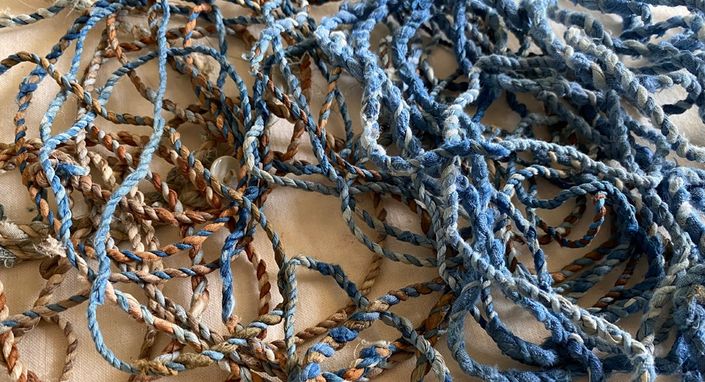
string things
how to twine beautiful string from plants or rags (and some suggestions for lovely things to make with it).
Watch Promo
I think the twining of string is one of the greatest technological leaps forward in the history of humankind.
We know that the history of string is at least 20,000 years old ... because that's the age of the pot shard that was found bearing an impression of it. But it could well be older.*
 Picture a sunny afternoon outside the cave towards the end of the Stone Age. Herr Earlyperson has gone off to chase a mammoth with his buddies, all hairy knees and the great outdoors. Frau Earlyperson (having already swept together the soft wolf-fluff dust-bunnies drifting across the cave floor and piled them to make a soft nest for the babies, thus laying the foundations for the first accidental making of felt) is watching the infants tumbling in the dust. She plucks a few strands of dry grass, idly twisting them between her fingers. It dawns on her that when twisted together, the fibres are considerably stronger than they are individually.
Picture a sunny afternoon outside the cave towards the end of the Stone Age. Herr Earlyperson has gone off to chase a mammoth with his buddies, all hairy knees and the great outdoors. Frau Earlyperson (having already swept together the soft wolf-fluff dust-bunnies drifting across the cave floor and piled them to make a soft nest for the babies, thus laying the foundations for the first accidental making of felt) is watching the infants tumbling in the dust. She plucks a few strands of dry grass, idly twisting them between her fingers. It dawns on her that when twisted together, the fibres are considerably stronger than they are individually.
Imagine her growing excitement as she explores the possibilities of different plants and bramble-caught animal fibres. The discovery is the beginning of what noted archaeologist Elizabeth Wayland Barber called "the String Revolution" in her splendid book "Women's Work, the first 20,000 years".
The twining of string led to the making of rope and the ability to construct tools, enclosures and nets. Very fine string (thread or yarn) made from plant (cotton, linen, hemp) or animal fibres (think silk and wool) could be woven to make cloth. The discovery of twining literally changed the world.
I had the great good fortune to be taught how to make string by one of Australia's most respected textile artists, Nalda Searles. I had been staying at her house as we were both exhibiting in the "Seven Sisters" exhibition in 2004 and out of the blue she kindly offered to teach me to twine, just before I was due to head to the airport to come home. Happily my fingers embraced the skill reasonably quickly and so I went to the waiting lounge armed with a bag of shredded silk shirt. The plane was delayed a couple of hours so by the time we were ready to board I had six metres of string nicely balled up.
Over the years I've twined string to tie up dye bundles, hang amulets around my neck and crochet shopping bags. I've sewn string into lace-like netting, stitched it into bowl forms, plied and crocheted it into horse ropes and dog leads.
I'd be delighted to string you a yarn or three about twining, and to help you find your way into your own string adventure.
The tools are simple. To begin with you'll need a pair of scissors and a bowl of water, and beyond that you should be able to find all the consumable supplies you need in your rag bag or out in the garden. If you don't have a garden of your own, you can glean from public parks or make friends with a gardener. As you become more adventurous in your makings, you may add decide to add crochet hooks and fat knitting needles to the mix. Maybe seashells and driftwood will come to play too.

And you'll learn the magical answer to the question "how long is a piece of string".
* As it turns out, since the class was published news of some very interesting discoveries has been released, and it seems the history of string goes back twice as far as was originally thought!
https://www.bbc.com/news/world-europe-52267383
https://www.nytimes.com/2020/04/09/science/neander...
your guide

artist, writer and wanderer
Frequently Asked Questions

